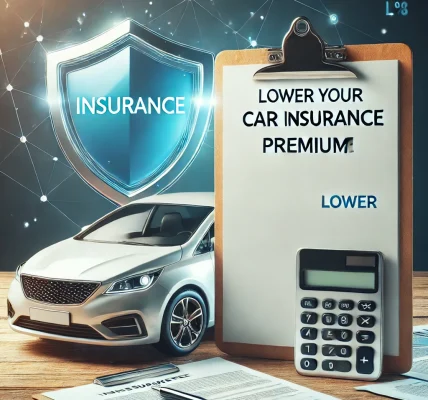Traffic violations are not just legal infractions; they also have a direct impact on your car insurance premium. Insurers assess risk based on your driving history, and repeated violations can result in higher premiums or even policy cancellations. Understanding the connection between traffic violations and insurance costs is crucial for maintaining affordable coverage.
In this article, we’ll explore how different types of traffic violations affect your car insurance premium, ways to mitigate the impact, and tips for maintaining a clean driving record.
Understanding How Insurance Companies Determine Premiums
Car insurance companies calculate premiums based on risk assessment. Several factors influence your insurance rates, including:
- Driving history (traffic violations, accidents, and claims)
- Type of vehicle (make, model, and year)
- Location (high-risk areas may lead to higher premiums)
- Age and experience (new drivers often have higher premiums)
- Credit score (in some regions, a lower credit score can increase rates)
Among these, your driving record plays a significant role. A history of traffic violations signals risky behavior to insurers, which may result in increased rates.
Types of Traffic Violations That Impact Insurance Premiums
Not all violations carry the same weight in determining your insurance rates. Some infractions have minor effects, while others can cause significant premium hikes.
1. Speeding Tickets
Impact on Premium: Moderate to High
Speeding is one of the most common traffic violations. If you receive a single speeding ticket, your premium might increase slightly. However, multiple speeding violations within a short period can result in steeper hikes or policy non-renewal.
2. Reckless Driving
Impact on Premium: High
Reckless driving includes aggressive behavior such as excessive speeding, tailgating, and ignoring traffic signals. Insurance companies view this as a serious offense, often leading to a 50% or more increase in your premium.
3. Running a Red Light or Stop Sign
Impact on Premium: Moderate
Running a red light increases the likelihood of accidents. It signals careless driving, leading insurers to raise your rates. Additionally, it may add demerit points to your driving record, further impacting your premium.
4. Driving Under the Influence (DUI/DWI)
Impact on Premium: Very High
A DUI conviction can double or triple your insurance premium. Some insurers may even refuse coverage, requiring you to seek high-risk insurance (SR-22). DUI offenses stay on your record for several years, making it difficult to secure affordable coverage.
5. Distracted Driving (Texting & Phone Use)
Impact on Premium: Moderate to High
Many states have strict distracted driving laws, and violations result in penalties. Insurers see distracted driving as a leading cause of accidents, leading to significant premium increases.
6. Driving Without Insurance
Impact on Premium: High
Being caught driving without valid insurance can dramatically increase your premium. Some insurers may categorize you as a high-risk driver, requiring special coverage that costs more.
7. Accidents Caused by Traffic Violations
Impact on Premium: Very High
If a traffic violation leads to an accident, your rates will likely skyrocket. Insurers consider at-fault accidents a red flag, often leading to a surcharge on your premium.
How Long Do Traffic Violations Affect Your Insurance?
The duration for which a traffic violation impacts your insurance varies depending on state laws and insurer policies. However, here are some general guidelines:
| Violation Type | Impact Duration |
|---|---|
| Minor Violations (Speeding, Red Light) | 3-5 years |
| Reckless Driving | 5-7 years |
| DUI/DWI | 7-10 years |
| At-Fault Accidents | 3-5 years |
Most insurers gradually reduce surcharges if you maintain a clean record after a violation.
Ways to Reduce the Impact of Traffic Violations on Insurance Premiums
While violations stay on your record for a certain period, there are ways to mitigate their impact:
1. Take a Defensive Driving Course
Many insurers offer discounts if you complete a state-approved defensive driving course. These courses refresh your knowledge of traffic laws and improve your driving skills.
2. Maintain a Clean Record
Avoiding further violations for a few years can help your premium return to a lower rate. Insurance companies reward responsible driving habits.
3. Shop Around for Insurance
Different insurers assess violations differently. Comparing quotes from multiple companies can help you find better rates even after a violation.
4. Consider Usage-Based Insurance (UBI)
Usage-based insurance programs track your driving behavior through telematics devices. Safe driving habits may offset higher rates caused by past violations.
5. Increase Your Deductible
If your premium has risen due to violations, opting for a higher deductible can lower your monthly payments. However, this means you’ll pay more out-of-pocket in case of an accident.
6. Take Advantage of Discounts
Check if you qualify for bundling discounts, low-mileage discounts, or safe driver programs. These can help counterbalance rate increases due to violations.
7. Remove Violations from Your Record
In some jurisdictions, you may be able to expunge minor violations from your record by completing traffic school or following a clean-driving period.
Final Thoughts
Traffic violations have a direct and lasting impact on your car insurance premium. While minor infractions may lead to slight increases, serious offenses like DUI or reckless driving can drastically raise your rates or even result in policy cancellation.
The best way to keep your insurance premiums low is to drive safely, follow traffic laws, and avoid repeat violations. If you do receive a ticket, taking proactive steps—such as completing a defensive driving course or shopping for better rates—can help minimize the financial impact.
By staying informed and making smart choices, you can ensure affordable car insurance while maintaining a clean driving record.
🚗 Safe driving pays off! 🚦




